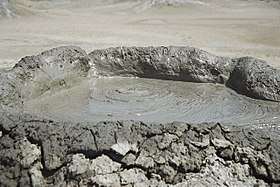Mud volcanoes in Azerbaijan

Over a thousand mud volcanoes are known to exist in the world, and some 400 of those are in the coastal area of Azerbaijan.
While mud volcanoes (also known as “sedimentary volcanoes”) never grow to the size of a normal volcano, topping out at around 10 km in diameter and 700 meters in height, (among the largest mud volcanoes in the world are Boyuk Khanizadagh and Turaghai, both in Azerbaijan) they do occasionally get the chance to show off, as happened in 2001.
Every 20 years or so, one of these mud/gas volcanoes will ignite deep below the surface and create a massive explosion. While generally not dangerous to people, as they are far outside of most city centers, it is believed that six shepherds and over 2,000 sheep were killed by a mud volcano in Bozdagh, Azerbaijan.
There is a silver lining to having a country covered in mud volcanoes. Mud volcanoes are closely associated with hydrocarbon and petrochemical stores underground, hence the gas trying to escape to the surface. A few of these gas leaks are constantly on fire, shooting small perpetual flames into the air and some believe that these perpetual flames are strongly connected to the appearance of the Zoroastrian religion in Azerbaijan some 2,000 years ago.[1]
Local people call them “yanardagh” (burning mountain), “pilpila” (terrace), “gaynacha” (boiling water) and “bozdag” (grey mountain) alongside its geographical name – mud volcanoes.
Submarine mud volcanoes
Underground and submarine mud volcanoes are also famed in Azerbaijan. There are more than 140 submarine volcanoes in the Caspian Sea. Eight islands in the Baku Archipelago are mud volcanoes by origination. The other kind of mud volcanoes are wells. Their activity can be observed among strata of various ages. According to the information, mud volcanoes initially began their activity in the territory of Azerbaijan 25 million years ago.
Eruption of mud volcanoes

About 200 eruptions have occurred in 50 volcanoes in the territory of Azerbaijani Republic since 1810. Eruption of mud volcanoes is accompanied by strong explosions and underground rumbling. Gasses come out from the deepest layers of the earth and immediately ignite. A height of a flame over volcano reaches 1000 meters (Garasu volcano). Toragay volcano erupted 6 times from 1841 to 1950.
Mud volcanoes are associated with oilfields. Rich oil and gas fields are found in the territories of mud volcanoes (Lokbatan, Garadgh, Neft Dashlari, Mishovdagh and others). In addition, lava, mud and liquid erupted by mud volcanoes are used as raw materials in chemical and construction industries and also in pharmacology.
Interesting facts
- Geologists of NASA studying Mars planet, concluded that mud volcanoes of Azerbaijan are similar to uplands of the planet for their structure.
- The eruptions of volcanoes are used as raw material in the chemical and construction industries as well as in pharmacology.
- Volcanic clay and mud are used in the treatment of diseases related nervous system, skin and rheumatism.
- On September 5, 2004 the greatest mud volcano in the territory of Azerbaijan was added into the Guinness World Records.[2]
- Otman Bozdag is the second largest mud volcano, according to the local media reports. Its eruption on September 23, 2018 produced mud extrusions that has reached 4 km long and cracks as deep as 80 m.[3][4]
References
- ↑ "Mud volcanoes of Azerbaijan". Atlasobscura. Retrieved 2018-09-24.
- ↑ "Largest mud volcano". Guinness World Records. 2004-09-15. Retrieved 2018-09-24.
- ↑ "Vulkan püskürən ərazidə çatların dərinliyi 80 metrə çatdı". Oxu.az. 2018-09-23. Retrieved 2018-09-24.
- ↑ "Vulkan püskürən ərazidə çatların dərinliyi 80 metrə çatıb". Bizimyol. 2018-09-23. Retrieved 2018-09-24.
External links
- Грязевые вулканы Азербайджана — одно из 7 новых чудес природы
- О природе грязевых вулканов. Профессор В. Н. Холодов. Геологический институт РАН, Москва
- Координационный Совет Азербайджанской Молодежи